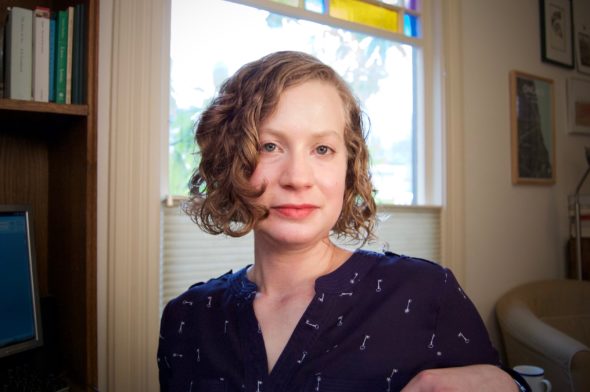Poems are tuning forks. When I am lost in the darkness of a novel-in-progress, fumbling through and then and then and then, they key me back into the precise and intimate. They pull me closer to the unknowable.
Anne Carson’s novel-in-verse, Autobiography of Red, was my gateway. It introduced me to contemporary poetry by luring me in with the promise of a story drawing on myth. (Myth and fairy tale are my literary lifeblood.) It also instigated my first novel, Daughters of the Air, by touching on Argentina’s Dirty War, which I hadn’t known anything about at the time. In one scene, Geryon, the red-winged monster protagonist, visits the University of Buenos Aires, where a long scroll of paper lists the names of professors ‘detained or disappeared.’ Carson writes: ‘Geryon was trying to keep his eye / from resting on any one name. / Suppose it was the name of someone alive. In a room or in pain or waiting to die.'[i] I researched that period for years, trying to understand how a government can turn on its citizens in this horrendous way—an estimated 30,000 people ‘disappeared.’ I was young, still in college; I’d thought that sort of thing ended with the Holocaust.

‘I read it for the freshness of language that contemporary poetry offers…’ Illustration by Josh Quick.
The first draft of the novel was written in fits and starts, yet the pace of the telling, I learned in an MFA workshop, was at break-neck speed. (See above referenced and then and then and then.) The summer between the first and second years of my MFA program, I attended the Port Townsend Writers’ Conference and took a workshop with the novelist and poet Chris Abani. Afterwards, I decided to restructure and entirely rewrite the book, to, among other things, give readers space to breath.
I also travelled to Argentina to complete on-the-ground research. While there, I picked up a bilingual edition of Jorge Luis Borges’s Selected Poems. (My Spanish is quite rudimentary. I thought it would be a great way to learn.) I had already read his short fiction and his collection of essays Seven Nights. I needed more.
Borges’s poems offered a sense of Buenos Aires in a time I could never experience firsthand. His images of tigers and moons, of garden patios and pink corner stores, helped me add to the landscape of my novel a texture I could not glean elsewhere. They also helped me develop Lolo, a character who’d left Argentina for Brazil soon after World War II and never returned, who continued to imagine that city as it was in her childhood, even as the novel’s chronological start is 1978. Her Borgesian library consists of hundreds of obscure dictionaries—an attempt to make sense of the universe.
Wisława Szymborska’s View with a Grain of Sand: Selected Poems (translated by Stanisław Barańczak and Clare Cavanagh) offered another angle on the subject of my novel. It showed me how to approach history and repressive governments with a light touch. I ended up choosing an epigraph from her poem ‘Sky,’ as it homed in on my protagonist’s visceral desire for escape: ‘The sky is everywhere, / even in the dark beneath your skin. / I eat the sky, I excrete the sky.'[ii] This poem that ends on a note of ‘rapture and despair’ was the right tone for a character trying to fly from her sense of loss, even as she falls deeper into it.
As I rewrote the novel, I read Chris Abani’s Sanctificum. At first, I read it because I was curious about his new book. Then I reread it because of its urgency, its themes of exile and loss, its meditations on places with traumatic history. And I read it for the freshness of language that contemporary poetry offers. These poems improved my writing by helping me shake off an old bad habit of trying to sound ‘literary.’ From ‘Om’:
‘Maps are like God.
They are the city yet not the city.
They contain the city but yet do not.
We trace the lines in loss.
Sometimes we find treasure.
Sometimes something fills the mind,
something at which we pause, stopped.
The way a photograph cannot remember the living.'[iii]
Here, as with Borges and Szymborska, there is that feeling of ghosts inhabiting where we walk. This is the atmosphere I kept returning to as I revised Daughters of the Air.
#
My second novel, quite different in style, and which I am revising, keeps me returning to Frank O’Hara’s Lunch Poems. O’Hara dashed off these poems during his lunch hours, a fact which touches on the central tension of my story. Binnie Greenson, a struggling diorama artist, works as a paralegal in a casino bankruptcy trial of catastrophic proportions during the economic crisis of 2008. She must question her identity and future as an artist. O’Hara’s vivid depiction of life in New York City in the 1950s and early ‘60s is also important. Binnie admires the nostalgic work of Joseph Cornell: collages and ‘dream boxes’ of young Renaissance princes, Victorian cutouts, dime store toys, and slick 1930s movie magazines. O’Hara’s poem ‘Rachmaninoff’s Birthday’ offers this assemblage, which achieves a nostalgic whimsy similar to Cornell’s:
‘Oh my palace of oranges,
junk shop, staples, umber, basalt;
I’m a child again when I was really
miserable, a grope pizzicato. My pocket
of rhinestone, yoyo, carpenter’s pencil,
amethyst, hypo, campaign button,
is this room full of smoke?'[iv]
Before sitting down to work on this novel, I often opened Lunch Poems at random, tuning in to that register of yearning and whimsy.
#
I’ve written a rough draft of a third novel, which is on the backburner. It’s about two painters, one a real figure in history and the other imagined. It’s too early to say what kind of poetry will help me write this novel. Above all, poems that tune me in to the aesthetic I’m striving for will be what I re-read to stay in key.
Perhaps because I’ve been reading poetry with some regularity for seven years now, it seems natural that I’ve begun writing poetry to include in the novel. The genre is seeping into my finger tips. Poems and paintings have a long history together, of course, so it shouldn’t be a surprise that the creative process has taken me in this new direction. I steep myself in short stories when writing short stories and essays when I write essays and novels when I write novels, and all the while I’m reading poetry daily. I suppose these poems that helped me write novels have, then, helped me write poems.
#
[i] Anne Carson, Autobiography of Red,(New York, Vintage Contemporaries, 1998), p. 90.
[ii] Wisława Szymborska, ‘Sky,’ View with a Grain of Sand: Selected Poems, translated by Stanisław Barańczak and Clare Cavanagh, (New York, Houghton Mifflin Harcourt), p. 174.
[iii] Chris Abani, ‘Om,’ Sanctificum, (Port Townsend, Copper Canyon Press), 2010, p. 8.
[iv] Frank O’Hara, ‘Rachmaninoff’s Birthday,’ Lunch Poems, (San Francisco, City Lights Books), p. 7.
 Anca L. Szilágyi‘s debut novel is Daughters of the Air. Her writing appears in Salon, Los Angeles Review of Books, and Lilith Magazine, among other publications. She is the recipient of the inaugural Artist Trust / Gar LaSalle Storyteller Award, a Made at Hugo House fellowship, and awards from the Vermont Studio Center, 4Culture, the Seattle Office of Arts & Culture, and the Jack Straw Cultural Center. The Stranger hailed Anca as one of the ‘fresh new faces in Seattle fiction.’ Find her at ancawrites.com or on Twitter @ancawrites.
Anca L. Szilágyi‘s debut novel is Daughters of the Air. Her writing appears in Salon, Los Angeles Review of Books, and Lilith Magazine, among other publications. She is the recipient of the inaugural Artist Trust / Gar LaSalle Storyteller Award, a Made at Hugo House fellowship, and awards from the Vermont Studio Center, 4Culture, the Seattle Office of Arts & Culture, and the Jack Straw Cultural Center. The Stranger hailed Anca as one of the ‘fresh new faces in Seattle fiction.’ Find her at ancawrites.com or on Twitter @ancawrites.
